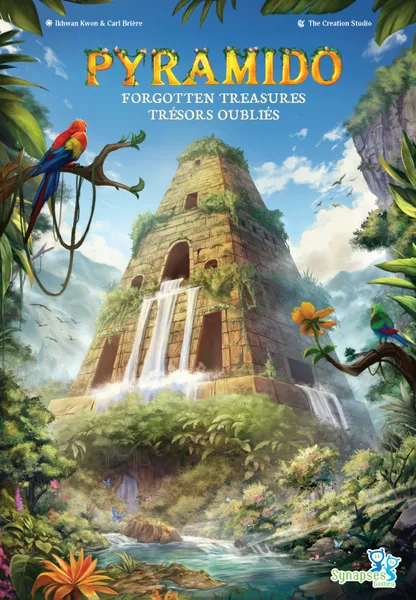Pyramido: Forgotten Treasures – BGA Review
Alright, I am still going strong on my goal of learning a new game each week on BGA. I am even a little bit ahead of the schedule, still I want to do one per week if I can still. This week’s game was Pyramido: Forgotten Treasures. Who can build up the best pyramid to score the most points from the gems that they find? Let’s talk about how this game plays and what works and maybe doesn’t work.
How To Play Pyramido: Forgotten Treasures
This is a very simple game. You make a 5 x 4 (or 4 x 5) grid. On your turn you select one of the three face-up tiles from five stacks of tiles. Your also take one of the gems next to that stack of tiles that’ll be used for scoring. Then you choose one of the facedown tiles to flip face up. After that you place your tile into your grid, and it always needs to be adjacent to another tile.
You do that until you complete your 5 x 4 grid. At that point in time you spend your gems to activate the area matching the color of that gem. Or you spend two wild gems to activate an area. And you decide which ones you want to activate.
Because after you complete that first round of building and scoring, you do it again. But now it’s a smaller area you are filling in. You leave the outside rows and columns empty and repeat the process. And you do that until there is a single tile on top.
Whomever has the most points from scoring their gems at the end of the game is going to win.
What Doesn’t Work?
This is an abstract game, so if you wanted theme in the game, it isn’t there. This idea of “forgotten treasures” in the title is just the gems. I think by looking at the game that is pretty obvious, but that’s something I wanted to call out. Because, I think the title does indicate there might be something thematic or adventure like about the game, this is a pure abstract game. Something I normally don’t love, but this is my only negative/word of warning.
What Works?
Turns are great and simple. I love how fast they go. You do need to think about things once in a while. Do I take that slightly worse tile in order to get the better gem for scoring. Or maybe will that come back to me again. But it’s very simple, I grab a tile, grab a gem, flip a tile, and you can take your turn while I place my tile. So the game, even on BGA being played asynchronously is one that can just fly if people happen to be online at the same time.
I also like the scoring in the game. I think that works really well. You activate the area(s) that you want to score by spending gems. But you also can overpay as well. If you pay two extra gems from the ones you collected when playing tiles, you score the ones printed on the tiles twice. So you if create a great area, then it might be worth to activate that one twice versus another lesser scoring area once. But that all depends on you having the right color of gems.
The pyramid building is the final thing that I want to talk about. Because you build up and leave an open row/column around the edge every time that sets up some scoring as well. If I pick and place tiles so that the gems on those tiles are at the edge of the are, they score throughout the whole game, as long as I activate that area. Even if that area isn’t on one of the tiles on top, I can always activate it along the edge. So I might want to focus on building out a specific area.
Who Is Pyramido: Forgotten Treasures For?
I think this is a great game for a lot of people. For gamers, it might be a little bit less thinky than they might hope for an abstract game. But for more casual gamers or people who maybe don’t play many games, this is an easy one to learn. And for those gamers, I do think the game offers a few good decisions each turn which works well. But I could see this as a game that becomes a family holiday favorite or something like that easily.
Final Thoughts on Pyramido: Forgotten Treasures
I enjoy Pyramido: Forgotten Treasures. And you know from some of my other reviews, like Harmonies, that I don’t always love abstract games. But this one works for me. I think it works for a few reasons that I mentioned above. But mainly, I think it works because you need to be a little bit adaptive as you play. But it still lets you come up with a plan for what you want to do and what you want to shoot for as you play the game.
And the game is fast. I think that is also a great element for the game. I said that it’s fast when you play it on BGA. And in person this game would just fly as you play it. So it just works really nicely that way for me as well while giving you a few clever things to think about. Mainly, how do you layer up your pyramid and when do you go from that really big scoring round, or do you just score everything (or as much as you can) once per level of the pyramid?
My Grade: B+
Strategy: B+
Luck: C-
Send an Email
Message me on X at @TheScando
Visit us on Facebook here
Support us on Patreon here

Leave a Reply
You must be logged in to post a comment.